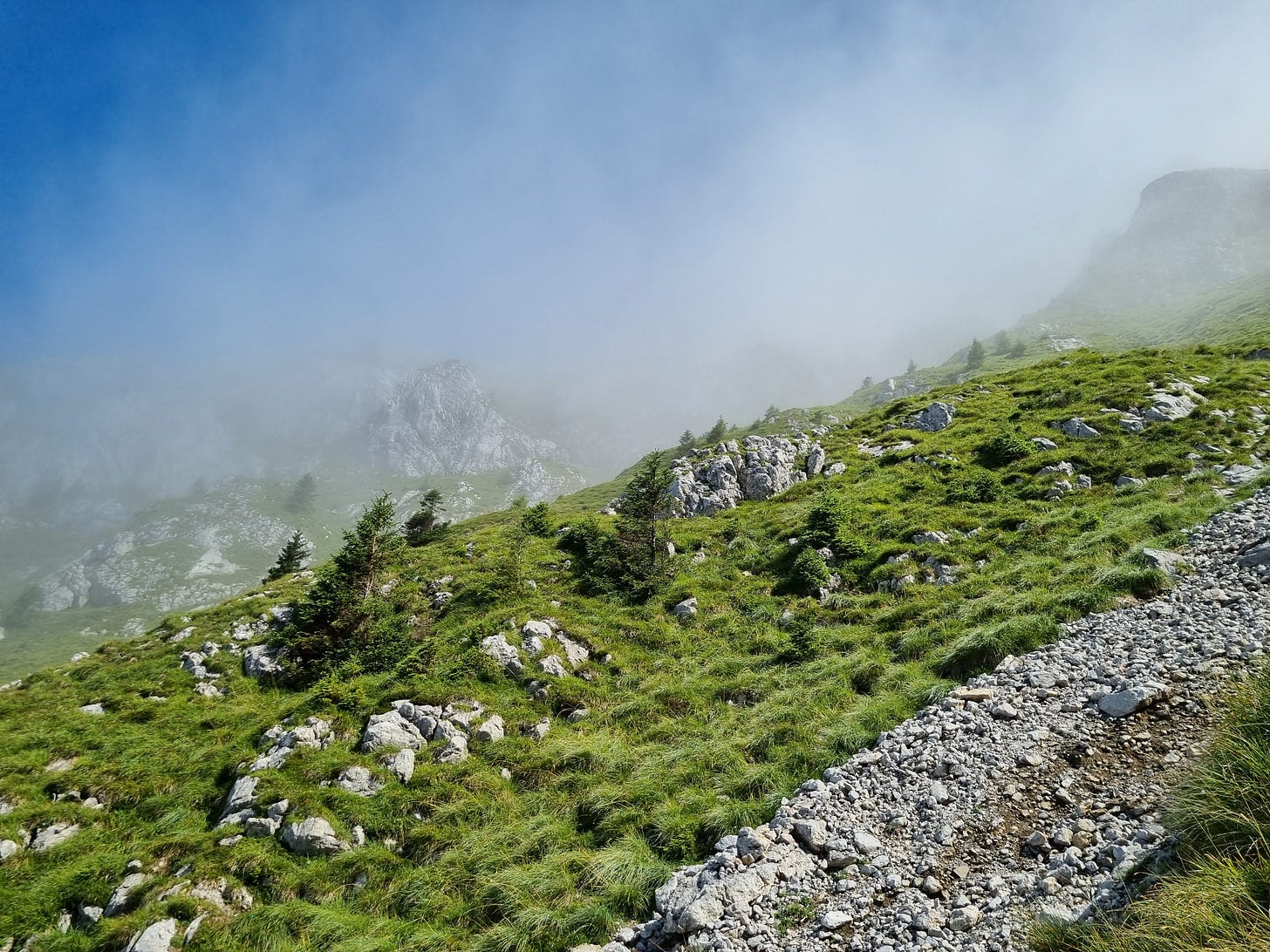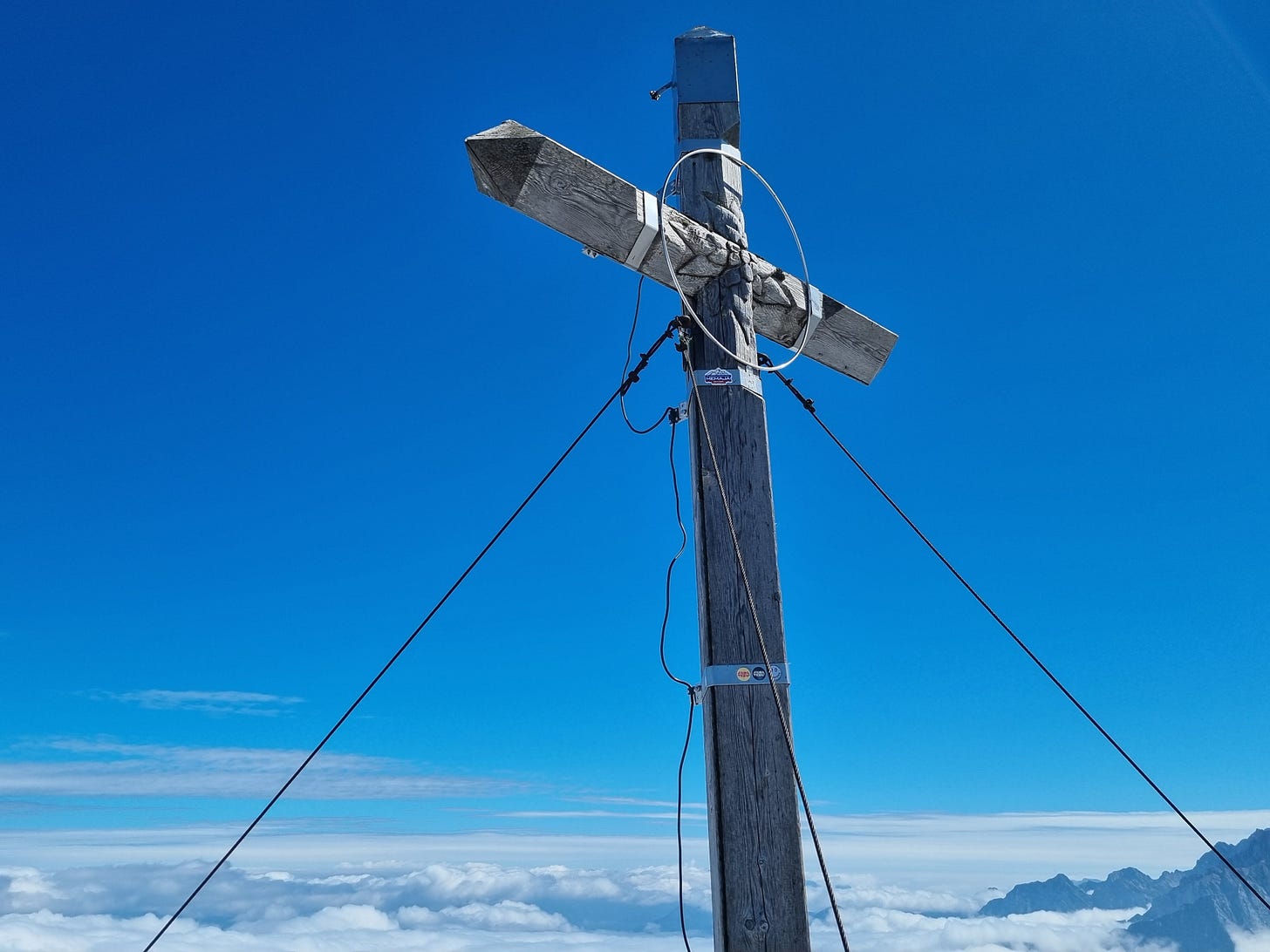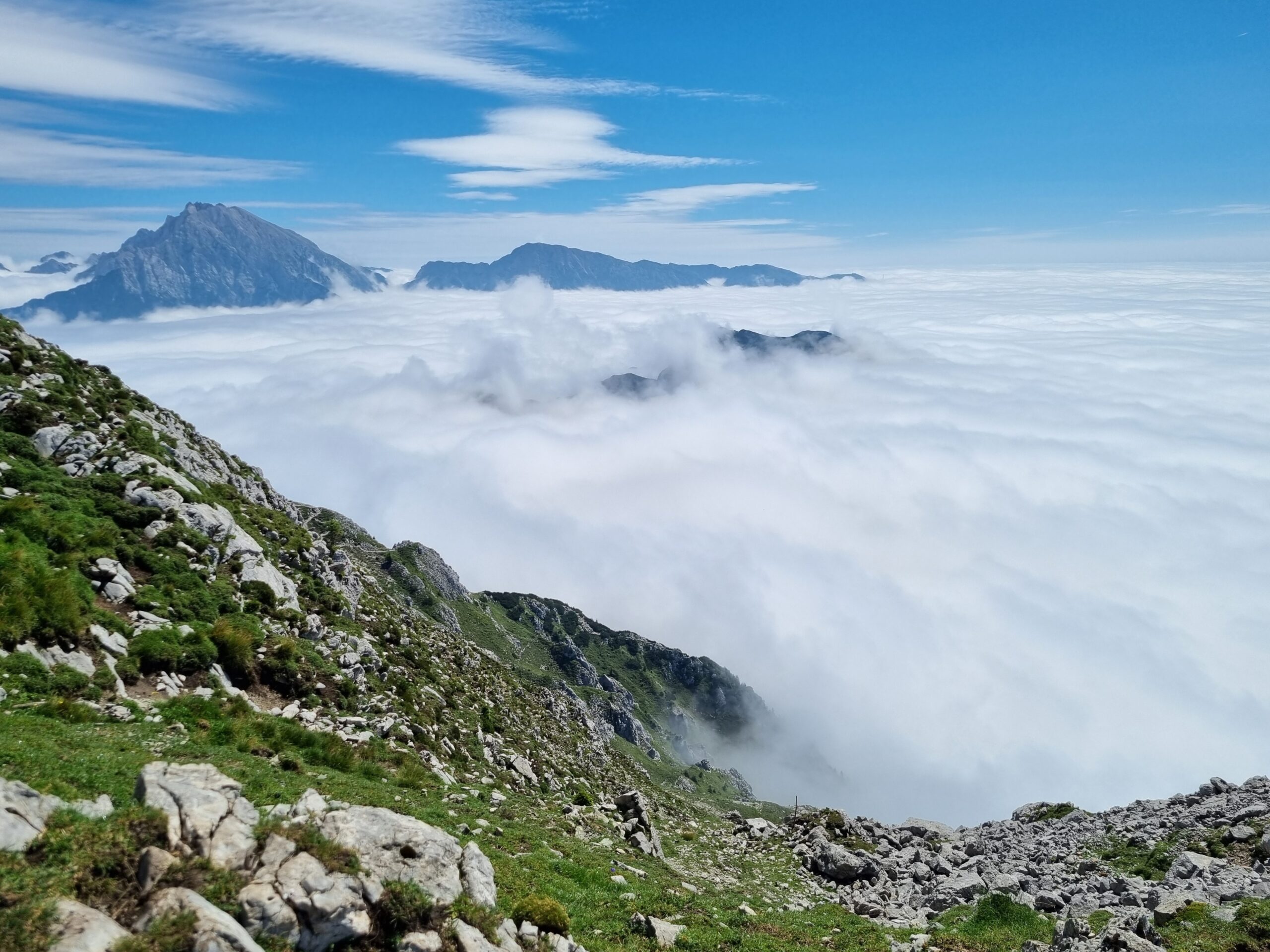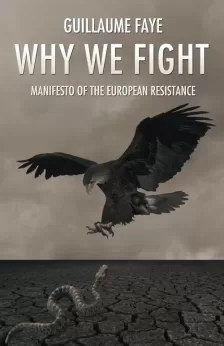The morning sun was hidden behind the grey clouds as the drops of last night’s rain were falling from the leaves of the trees on the forest path that leads towards the mountain that was to be conquered that day. The stones were wet and the path was muddy, which meant that every step had to be taken carefully. It was a calm walk through the woods that were shrouded in fog. Only the aforementioned falling drops, and an occasional bird, were disturbing the serene silence of the forest. Faded signs and marks on the trees showed the way forward, sometimes hidden beneath the boughs and green summer leaves. The whiteness of the mist was another cause for caution, as trail signs could be overlooked and missed if one was too hasty in one’s steps.
This was indeed the case. After an hour or so of hiking through the damp forest, the path went upwards, leading to the green pastures, where cows were grazing, stopping for a second to take a closer look at the lone traveller and continuing with their meal after they had decided that the outsider didn’t pose any threat. Then the path led to a lone cabin, where the signs informed me to take a right turn back to the forest. Before me lay a very narrow, straight trail, going under the trees and sometimes leading beside precipitous slopes, deep enough to make me feel a bit uneasy, as the ground was wet and slippery. Soon, the narrow track ended, and another lonely mountain cabin appeared before me. Only a few steps ahead the main ascent began. But the mist would not release me from her embrace so easily. Her thickness swallowed the sign showing the right way upwards. Because of this, I was unable to find the right path right away. But soon my fortune returned. After wandering around for a short time, I decided to retreat my steps back to the cabin. At that point, I noticed by chance the marcation of the desired path winking at me from across the wider dirt road that connects the cabin with the civilization below. Soon I was back on the right path, steadily ascending across the steep and slippery terrain of wet grass, stones and dirt.
Here is where one becomes aware that one is mountaineering, and not just taking a casual stroll in the woods. Trees and bushes, mostly evergreen conifers, become rarer as the scenery slowly changes. Throughout the mist and the milky white clouds, the silhouette of the majestic Alpine peak, on which the traveller will soon stand, appeared, solemn and awe-inspiring. The landscape becomes a mosaic of mostly grey rocks, stones, and boulders intermingled with the vividly green grass that adorns the steep slope upon which the traveller is ascending towards his goal.
Partly inspired by Julius Evola’s book Meditation on the Peaks, a collection of essays, which I had recently read, I followed his advice by contemplating the positive effects of mountain hiking on one’s spirit and character. At the same time, I stayed focused on my steps, as the trail was still wet and slippery, causing a smaller and harmless slip, just to remind me that the natural world is not just a place of eternal beauty and wonder, but also a place of smaller and greater dangers. The hike that I chose that day cannot be compared with the Alpine climbing that Evola undertook in the Dolomites and Alps. It is labeled as easy on a difficulty scale, yet it still demands at least moderately good physical condition, as it takes almost five hours to the top with a steady pace, and one has to conquer an altitude of about 1,400 meters from the starting point to the summit.

As I ascended into the cloud, the mist and damp still surrounded me, and the path was getting steeper. Then all of a sudden, the mist retreated before the blue sky and the sharp light of the August sun. I came through the cloud that now hovered behind and beneath me, and filled the valley below with its pure whiteness. The unconquered sun, the source of all life, blinded me, but I confidently walked on, while I felt the warmth that reinvigorated my body and spirit, and swiftly dried my clothes and skin, wet from the morning forest dew. I remembered how Evola criticized those who have turned hiking and mountaineering into just another sport, another pastime activity, without any higher meaning. But that day I was lucky enough to find myself alone in the kingdom of the mighty Alps, once again appreciating and wondering at the power and beauty before my eyes.
The feeling of standing before the great peaks that look like they are eternal and indestructible, the symbols of nature’s superiority, might and indifference, always fills me with the same joy, awe, and happiness that I am, that I exist, and that I have the privilege to find myself in the shadow of these stone kings and queens. Beneath them, countless generations of my folk were born, struggled, laughed, cried, toiled and died throughout the centuries. This is not the “bourgeoise” idealization of the mountain world from afar, which Evola criticized and dismissed. It is also not a form of escapism from everyday life. It is an experience that makes one feel more alive, and concerning what Evola wrote, makes one forget all the banalities of life in the plains. Here among the clouds and majestic peaks, the petty everyday problems and complications seem small and unimportant. Simultaneously, one feels new strength and will to live and carry on. Mountaineering offers an individual a unique opportunity to become more aware of his being, to feel the increased intensity of life itself, and to intimately reconnect with his roots, his soul and his homeland and ancestral legacy. If he is aware of this and can seize this opportunity to strengthen his character and spirit, and at the same time find a new joy and strength in the fact that he exists, he will return from the mountains with a new confidence and a new determination. Such are the moments that inspire one’s will and spirit.
After taking a breath, I continued, knowing that the final goal of the day was not far away. The path became steeper once again, and in some parts, the “Nordic” walking poles were not always enough for me to keep my balance, so I had to grab onto a boulder or a rock with my hands on some turns of the winding trail that led me to the top. Above the breathtaking scenery, the sun shone as a joyful and righteous king overlooking his realm. As Odin, sitting on his throne Hlidskjalf, seeing everything that takes place beneath him. The mighty and invincible sun dried the path before me, so there was no more danger of slipping on a wet rock. Soon, I reached the mountain saddle, where I turned left. This was the final stage of my short journey, where I was now surrounded by the milky white clouds beneath me. After a few minutes I could already see the wooden cross erected on the summit. The final destination was before me. A few more steps, and I was sitting on a small rock, enjoying my triumph of the day, having reached the top. There were a few more hikers around, who came from different directions. Everybody was enjoying the warmth of the sun and the views. Will they take anything more from this trip than just a few photos and a vague memory of another summer hike? In hindsight, I remember the quote from Meditations on the Peaks:
It does not matter that the heroic symbolism of the mountain can only be experienced initially by a few people. When these meanings are duly focused upon, they will influence people. There is no real climber who is not able to experience mountain climbing, if only in a few occasional flashes, as something more than mere sport.
While Evola is talking about mountain climbing, which is much more dangerous and demanding than the few-hour hike that I described, I believe that the above is valid for many hikers as well, regardless of the differences in difficulty. There is something in mountaineering or in hiking — the great and majestic peaks that connect us with our land and with our ancestral heritage. Mountains, these great monuments of nature, represent for many European peoples who have lived from time immemorial under the Alps, Dolomites, Carpathians or other mountain ranges, an important symbol of their ethnocultural heritage and traditions. Some peaks are directly represented in national symbols, as is the case in my country, where the highest peak of our land is depicted in our coat of arms, while in other examples images of certain mountains personify specific regions or countries. Mountains are, of course, also an important element of national legends, tales or myths, and are also present in national cultures through art, paintings, songs, and so on. Further, mountains are not just symbols which hikers can consciously or subconsciously connect to the land, its people, history and culture. As Evola explained, our ancestors saw mountains as divine places, the dwelling places of gods and other divine beings. The most known example is of course Mount Olympus in Greek mythology. They also represent in a spiritual sense the will to overcome oneself and test one’s abilities and courage. Mountains are not just places where gods and goddesses dwell but also places where heroes find their home.

On top of the 2,132-meter-high Alpine peak Storžič, situated in the Kamnik-Savinja Alps, there is a wooden cross proudly standing as a symbol of the resilience and faith of the people who erected it on that spot. In its center it has engraved the Edelweiss flower, a known symbol of mountaineering. Looking at it, I wondered how many storms it has weathered and how many times it has been struck by lightning. The people who placed it there likewise belong to a nation that has weathered many storms and tribulations of history. Of course, this holds true for Europeans in general. Will this cross be replaced one day by the distant descendants of those who raised it with a new one, when the teeth of time start showing their mark on its surface? Or will it stand there silent and forgotten, while in the valley below the world changes and forgets the old ways and mores? We know that there are many such wooden or iron crosses on the peaks of the Alps and other mountains all across the old continent. They were most likely raised there as a continuation of an even older pre-Christian tradition of our ancestors, who saw mountains as divine places. For many, a mountain still has a divine character in a sense, even if only subconsciously. It is a place of intensity and serenity, of action and calmness. I looked around and saw the sea of clouds from which only the highest surrounding peaks were seen raising their proud heads above it. After having a rest and enjoying the views, it was time to return to the valley, to the “modern world” with all of its commotions and anxieties, which seemed so unimportant and trivial up there. Reinvigorated by my latest hiking accomplishment and the feeling of a newfound strength, I slowly descended, watching my steps, while contemplating the intense yet serene experience of that day and thinking about what should be the next hiking destinations before this year’s White Boy Summer is over.







